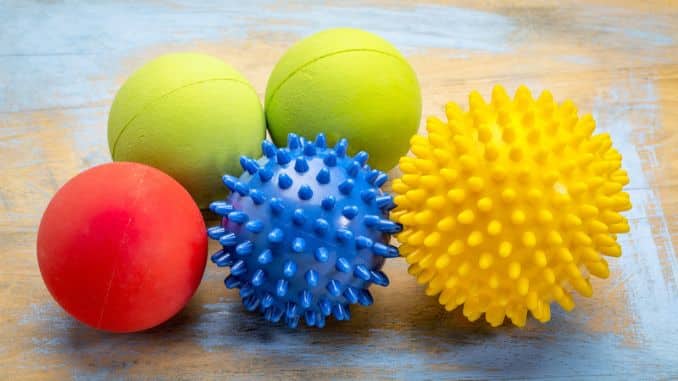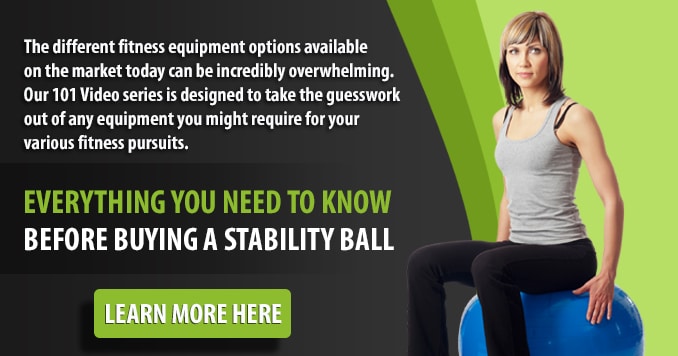Ever feel sore, stiff, or just plain tight? Self-myofascial release (SMR) is a fancy term for a simple fix: using pressure to melt away knots and boost mobility. And the best part? All you need is a massage ball.
These pocket-sized power tools are cheap, easy to use, and incredibly effective—whether you’re an athlete, desk jockey, senior, or gym junkie. Say goodbye to tension and hello to fast, feel-good relief right at home.
A study suggests [1] using a soft massage ball (SIRB) for self-massage to release tight muscles and reduce pain effectively.
1. Calf Roll
For this exercise, use a massage ball.
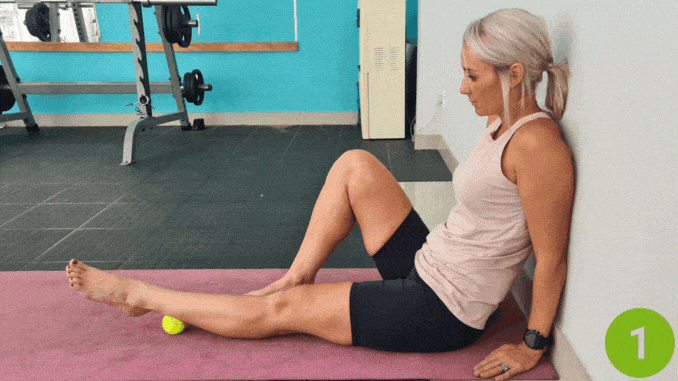
- Begin by sitting on the floor with your legs extended straight out in front of you.
- Place a small massage ball or lacrosse ball under one calf, just below the knee.
- Maintain good posture with your back upright and core engaged.
- Slowly roll the ball along the calf muscle, starting at the bottom of the knee and moving toward the ankle.
- Apply gentle pressure with your body weight, rolling the ball back and forth to target any tight areas.
- Repeat the movement for both calves, adjusting pressure as needed for a deeper stretch or massage.
2. Sole Roll
For this exercise, utilize the use of a massage ball.
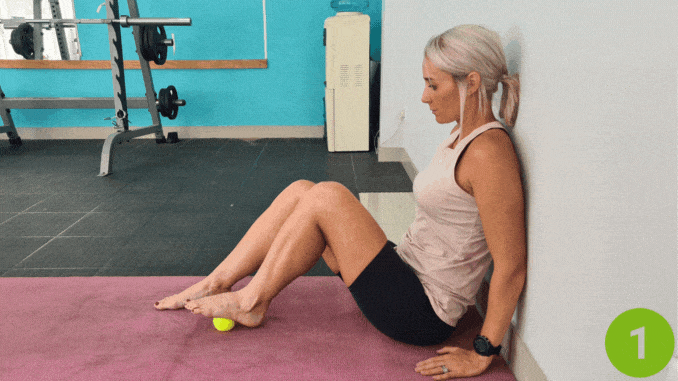
- Begin by sitting on the floor with your legs extended out in front of you, keeping your back straight and core engaged.
- Place a small massage ball or lacrosse ball under the arch of one foot.
- Gently press your foot down onto the ball, allowing it to roll along the sole of your foot.
- Slowly roll the ball from your heel to your toes, adjusting pressure as needed to target any areas of tightness or discomfort.
- Continue rolling for a few breaths, then switch to the other foot.
This exercise helps to release tension in the foot and can be especially helpful for those experiencing foot soreness or tightness.
3. Side Shoulder Rolls
For this exercises, utilize the use of a massage ball.

- Begin by standing with your feet hip-width apart and your back straight.
- Place a small massage ball against the side of your shoulder, leaning against a wall for support.
- Gently roll the ball up and down along the side of your shoulder, applying light pressure to release any tension in the muscles.
- To deepen the stretch, slightly bend your knees and sink into a mini squat while continuing to roll the ball.
- Hold this position for several deep breaths, focusing on relaxing your shoulders and allowing the ball to work through any tight spots.
- After a few breaths, switch sides and repeat the movement for the other shoulder.
This exercise helps alleviate shoulder tension and improve mobility in the upper body.
4. Shoulder Back Roll

- Begin by standing with your back against a wall, placing a small massage ball between the wall and your upper back.
- Position your feet hip-width apart and engage your core for support.
- Slowly lower your body into a seated position, keeping your back pressed against the wall while the therapist applies gentle pressure to your upper back.
- Roll your body up and down slightly to move the ball across your upper back, focusing on any areas of tightness or discomfort. Adjust your positioning to target different parts of your upper back, rolling from one side to the other.
- Hold this position for several deep breaths, allowing your shoulders and upper back to relax and release tension.
- After a few breaths, slowly rise back up and repeat the movement as needed.
This exercise helps alleviate tension and improve flexibility in the upper back and shoulders.
5. Neck Roll
For this exercises, utilize the use of a massage ball.
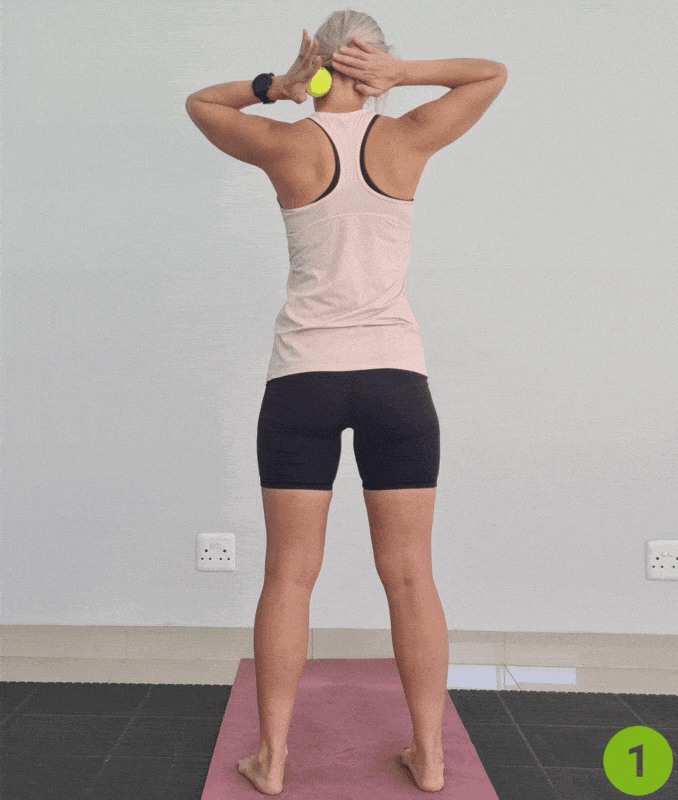
- Begin by standing with your feet hip-width apart, maintaining good posture and a straight spine.
- Place a small massage ball behind your neck, using your hands to gently hold it in place.
- Engage your core and relax your shoulders.
- Slowly begin to roll your head forward, bringing your chin toward your chest.
- Rotate gently to one side and return to the starting position, avoiding full circular motions.
- Keep the movements slow and controlled, focusing on stretching the muscles of your neck and upper shoulders.
- After completing a few rolls in one direction, reverse the direction and continue.
- Perform the movement for several breaths, inhaling deeply through your nose and exhaling through your mouth.
This exercise helps release tension in the neck and upper back, promoting relaxation and increased flexibility.
6. Palm Roll

- Begin by standing with your feet hip-width apart and your posture tall and relaxed.
- Hold a small massage ball in one hand, with your palm facing outward.
- Bring your arm across your body and gently press the ball into the palm of your opposite hand.
- Slowly roll the ball in small, controlled circles in one direction, focusing on massaging the palm and the muscles of your forearm.
- After completing several rotations in one direction, reverse the movement and roll in the opposite direction.
- Engage your core to keep your posture stable throughout the exercise.
- Repeat this movement on the opposite hand.
This massage ball exercises helps release tension in the hands and forearms, improving mobility and circulation.
7. Glute Roll
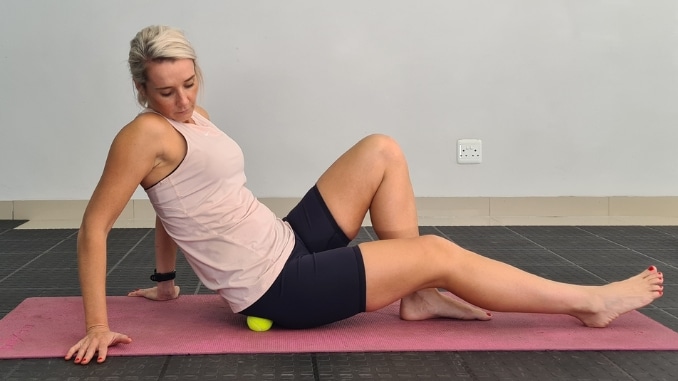
- Begin by sitting on the floor with your legs extended out in front of you.
- Place a massage ball under your glutes (the muscles of your buttocks), just beneath one side.
- Use your hands behind you for support as you lean slightly to the side where the ball is positioned.
- Gently roll your body back and forth to move the ball across your glute muscles, focusing on any tight or sore spots.
- Apply light pressure with your body weight, adjusting your position to target different areas of your glutes.
- Hold the position for a few seconds over particularly tight areas, allowing the ball to massage the muscle.
- Repeat on the other side.
This exercise helps release tension in the glutes, aiding in muscle relaxation and improving mobility in the hips.
Important Note: Improper use of a massage ball on the gluteal area led to sciatic nerve injury [2]
Massage Ball for Trigger Points:
- Self-massage with a tennis ball is an effective and low-cost way to address trigger points and reduce muscle pain.
- By applying pressure with a tennis ball, you can target and release the tension in muscles, helping alleviate discomfort.
- Using the ball helps massage deep into the muscles, providing relief from muscle knots and improving muscle health.
Doctor Jo suggests using the ball to relieve pain in common areas such as the calf muscles, glutes, and upper back by gently rolling it back and forth.
What Happens in Your Body
- Rolling with a massage ball increases blood flow to sore areas.
- It may help promote lymphatic drainage and reduce inflammation, alleviating pain.
- It can block pain signals from reaching your brain by activating certain nerves.
- Reduces low back pain. [3]
- Enhances psychological well-being by reducing stress and supporting mental health.
Conclusion
Massage ball exercises are great for relieving pain and tension in sore muscles. Whether using a golf ball, squash ball, or other types, these exercises target areas like the shoulder blades, glutes, and feet. They help improve blood circulation and provide immediate relief by pressing on trigger points.
Techniques like self-myofascial release and deep tissue massage can improve flexibility and mobility. These exercises also help with conditions like carpal tunnel syndrome. By focusing on proper technique and breathing deeply, massage ball exercises are an easy, effective way to reduce muscle tightness and boost relaxation.
So check out this Stability Ball 101 now!
Frequently Asked Questions
Do massage balls work?
Yes, massage balls work! They help relieve pain and tension by applying pressure to trigger points in muscles, such as the shoulder blades and other tight areas. Whether you’re using a golf ball, squash ball, or another type, massage therapy with a massage ball offers effective deep tissue massage that can help with sore muscles and improve blood circulation. It’s an easy way to get immediate relief from muscle tightness and discomfort.
Where should you avoid using a massage ball?
Avoid using the massage ball on sensitive areas like your spine, directly over joints, or near your neck. These areas are vulnerable to injury, so it’s best to focus on muscles like your back, legs, or forearms.
How long should you use a massage ball?
Use the massage ball for 5-10 minutes in each area. For example, spend a few minutes on your shoulder blades, then move to another tight spot, like your calves or forearms.

